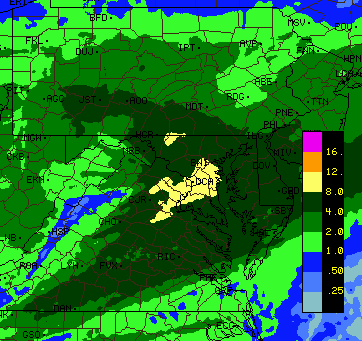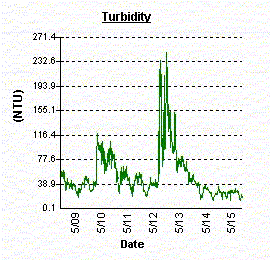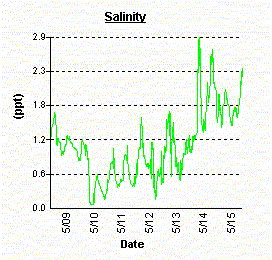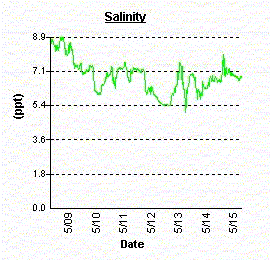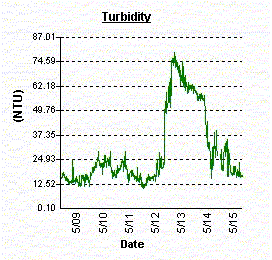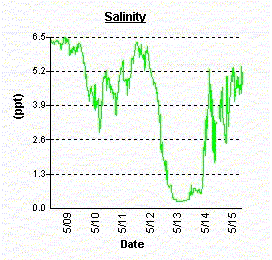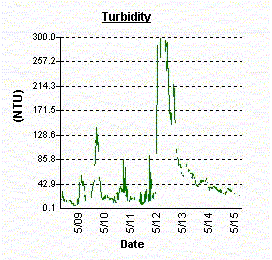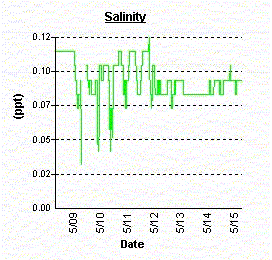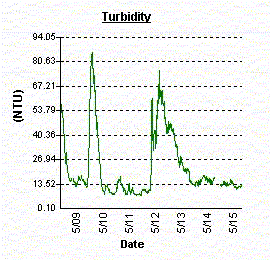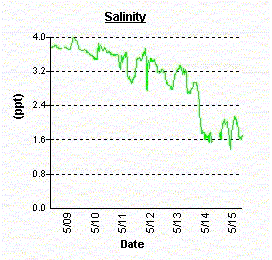|
The Chesapeake Bay region received a one-two punch of powerful storms between May 9 – 12, 2008. The two unnamed spring storms were responsible for flooding in much of the Bay watershed, with central Maryland being particularly hard hit. Along with the downed trees and damaged properties, the storms also impacted water quality in the area's streams, creeks, and rivers. The rains were responsible for dumping over 4 inches of rain throughout most of Maryland. Counties surrounding Washington, DC recorded over 8 inches. Watershed-wide radar estimates of rainfall can be observed in Figure 1. Figure 1. Area Precipitation Totals
Source: www.intellicast.com The region had previously been in the midst of a nearly year-long dry spell, but with the heavy precipitation this spring, the drought may be over. While the rains will have long term benefits such as recharging groundwater levels, in the short-term, they were responsible for carrying large amount of sediments and nutrients into the Bay. Looking at the network of real-time Continuous Monitoring sites in Maryland's portion of the Bay, clearly shows the immediate effects of the storms on Bay water quality. Continuous monitoring data, available on the Eyes on the Bay website, recorded many interesting impacts throughout the Bay (Figure 2). Data from the upper Bay show a short spike in turbidity levels. Turbidity is a measure of water clarity - higher turbidity indicates less clear water. Turbidity levels rise when sediment and other suspended material enter the water body during rain storms. Other factors, such as algae blooms, may also negatively impact turbidity levels. Poor water clarity prevents underwater grasses and other aquatic resources from thriving. The timing of this rain event corresponds to the early part of the SAV growing season (April – October) when plants require more light to reach the bottom sediments. DNR will continue to assess SAV beds to determine the impacts of these high rain events and subsequent turbidity spikes on SAV abundance throughout the summer. Figure 2. In addition to the water quality impacts noted above, there are several other immediate effects of the rains. Some area wastewater treatment plants were overwhelmed and discharged untreated wastewater into creeks or rivers. Also, many sediment and erosion control devices failed because the 4+ inches of rain exceeded the amount that they are designed to manage. The enormous amount of runoff funneled into small streams and creeks surely caused further erosion, which contributed to more sediment entering Bay waters. What can I do to lessen impacts on the Bay? Storm events of this magnitude provide another reminder of the impact that impervious surfaces such as roads, rooftops and parking lots have on the natural landscape. There are many things you can do to help improve the health of the Chesapeake Bay and its tributaries:
Sources of information:
|
|||||||||||||||||||||
